DMK 21AF04.AS - Ring Artefact Testing
2009.12.11.
Several users of the TIS DMK21 series cameras reported ring like ghost image artefacts in their images that seem to duplicate bright highly contrasted rims in the images. Discussions in several forums
substantiated the assumption that these artefacts occur only when the camera is operating at 60 frames per second. Since I experienced
onion ring like artefacts with my Foculus FO124B camera a while ago I wanted to test the DMK regarding ring artefacts in detail and determine
the root cause. My first goal has been to reproduce the artefacts indoors in a controlled test setup to be independent from weather, seeing and visibility of
celestial objects.
Test setup: The DMK21AF04.AS has been attached to a MC Rubinar 5.6/500 Maksutov lens, no filters used. The replacement planet target has been a
bracelet of my daughter with plastic perls. The perls are quite shiny (high albedo planet;]) but nothing else has been available for quick test.
The target has been lit by a reflector filament bulb that should emit quit strongly in the near infrared.
The object size and distance of the telescope to it will not create any diffraction pattern artefacts that could falsify the test.
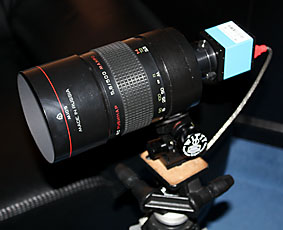
|
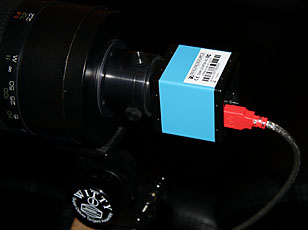
|
Test case 1
Camera setup:
Integration time: 1/826s
Gain: 1024 = full
Brightness/Black Level: 0 = off
Gamma: 10 = linear
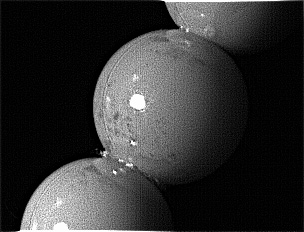
60 frames per second
|
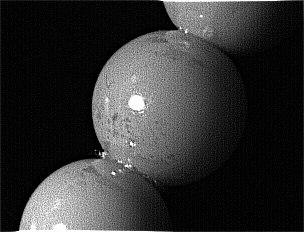
30 frames per second
|
Conclusion
A ring artefact is clearly visible in the 60fps image as a double contour of the lit rim of the target, it is not present at all in the 30 fps caption.The images show clearly the non-random noise pattern of the camera. Since the object is not moving on the CCD at all like it would in real world planetary imaging due to mount inaccuracy, wind, vibrations, seeing etc.
Test case 2
It has been assumed that ghost imaging is introduced into the interline transfer lines of the CCD by bright images on the CCD. If this is correct, the ghost images should appear independed from the light/photon integration process since the readout process is always the same. I've chosen the shortest possible integration time of the camera of 1/10000s, all other camera and processing parameters have been identical to test case 1. The image projected on to the CCD in this test runs is much brighter than real world planet imaging, hence parasitic currents introduced into the transfer line should be very present here if the assumption is correct:
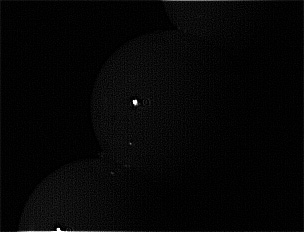
60 frames per second
2x upsampling, contrast enhanced: 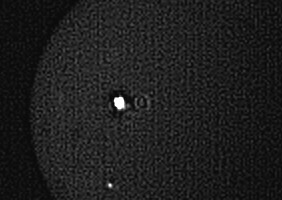
|
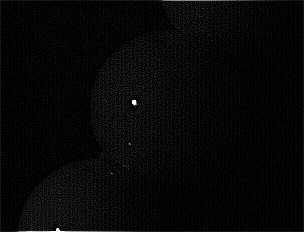
30 frames per second
2x upsampling, contrast enhanced: 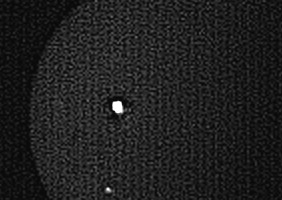
|
Conclusion
The ghost image of the bright rim is not visible in both images, hence I assume that a bright projected image introducing parasitic charges into the transfer lines is not the cause for the artefacts. What is visible is the ghost image of the bright highlight on the pearl in the 60fps capture with a positive x-offet, this is not visible in the image captured with 30fps.Test case 3
To get closer to real world imaging I introduced some artificial seeing to the setup with 2 candles just underneath the light path to the target. Camera and processing parameters have been identical to test case 1 but only the 400 best frames have been used in Registax for stacking this time:
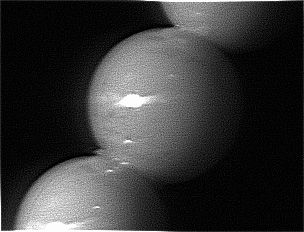
60 frames per second
|
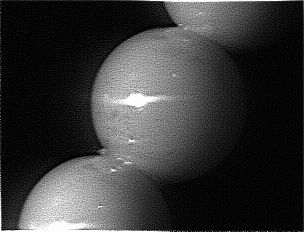
30 frames per second
|
Conclusion
The artefacts are present again in the 60fps capture but not in the 30fps capture. The ghost image rings are blurred more than in case 1 and look very much like the ones seen in real planetary images taken with the camera at 60fps. Systematical noise is less present in these images since the target moved slightly on the CCD due to seeing and the stacking process registered different areas of the CCD area on top of each other.Overall conclusion
The artefacts can be produced with a test target. They occur only at 60fps and are not present for 30fps. Measuring the distance of the ghost images to their origins shows a constant offset of ~+11px on the x-axis and none for y. Looking at the charge transfer direction in the interline readout of the CCD I can't see any relationship of the ghost images to parasitic charges intriduced into the transfer lines. Also I see no evidence for RBI (Residual Bulk images) since the artefacts occur with a static non-moving image on the CCD. The datasheet of the ICX098BL CCD used in the DMK2104 states that the CCD is intended to be used with max. 30fps for a complete progressive scan readout. 60fps should only be possible for the 'monitor mode' reading 2 lines and skipping the next 2 lines of the image. Maybe the CCD is oeprated outside its specification with 60fps and full progressive scan transfer. To avoid the ghost image artefacts the camera should not be used operating at 60 frames per second. This is quite a bummer since 60fps are very effective to capture many frames of bright and fast rotating planets like Jupiter in a short timeframe and makes life easier for all bright targets in general.One might think of a software filter applied to all raw frames before stacking that can eliminate or at least weaken the artefacts since the ghost images seem always to be present at a fixed position in positive x-direction.
